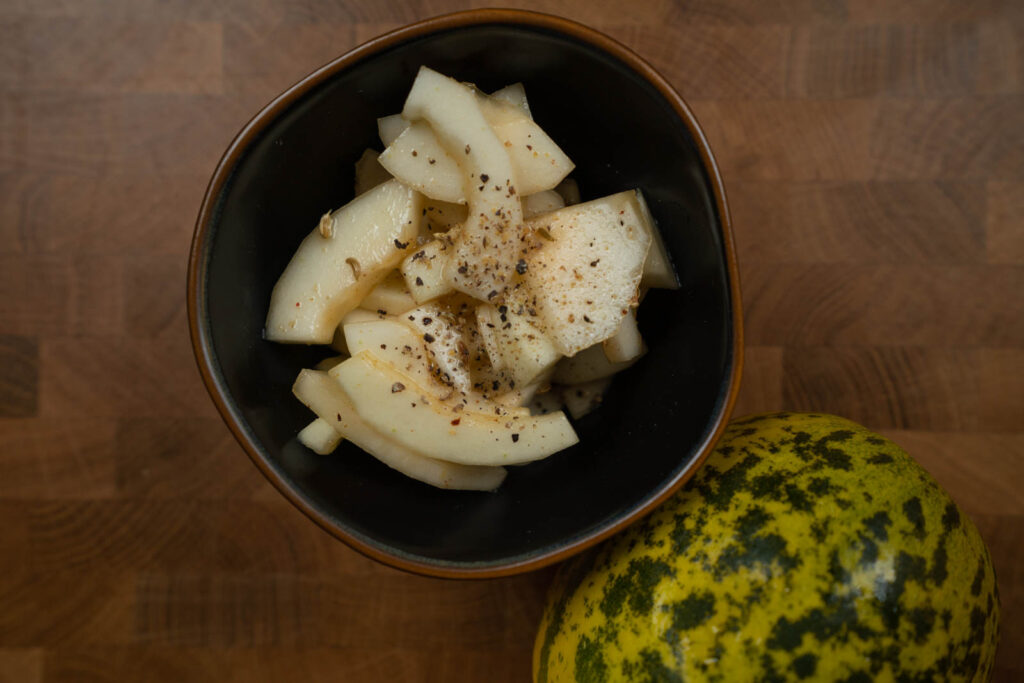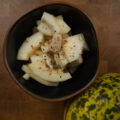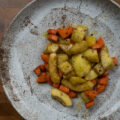What is a Sambar Cucumber?
It is summertime and peak farmer’s market season here in the Bay, and we stumbled on this crazy looking cucumber last week so we knew we had to make another episode of “What the F Is This?!”.
Apparently, these dinosaur looking eggs are called Sambar (Sambhar) cucumber, after the signature lentil chowder of South India that it’s often used in. But it’s also called a Dosakai Cucumber, or yellow cucumber but is not quite the same as lemon cucumber. It also goes by Field Marrows, Malabar cucumbers, Madras, Mangalore, and Magge, Dosakaya, Bollari, and Mogem. They’re small, like an orange or chayote size but oblong in shape. What caught our eyes was its beautiful yellow and green stripes and spots. The yellow darkens to almost orange as the cucumber ripens.

Where Sambar are From
As you might have guessed, this cucumber is native to India and most popular in Southern India cuisine. Nowadays, they can be found in local markets in India, China, Myanmar, Nepal, Pakistan, Sri Lanka, Bhutan and all the way here in the States.

Sambar Uses & Cooking
While they are botanically classified as a cucumber, they’re a part of the melon and squash family and are could be said to have more of those characteristics. For example, the flesh is pale and white with a mild sweet fragrance like a melon. The rind and seeds are edible like a cucumber, but they’re quite tough and most folks prefer to skip the seeds as they can be bitter. Sambar can be eaten both raw or cooked, but cooking can rid any bitter or sour notes. Some people claim the yellower ones are better for cooking while the greener ones are better for raw. Either way, taste your cucumbers first before deciding the application.
Fortunately these cucumbers are some of the hardiest ones (unlike our beloved Persian cukes) and will keep for a couple of weeks when stored in the crisper drawer of the refrigerator. And now, let’s get to cooking and tasting them ourselves! We’ll try them raw in a spiced and pickled application and then cooked in a simple stir fry, but these cucumbers are super versatile so don’t be afraid to make up your own recipes!

Sambar Nutrition
Like most cucumbers, sambar are mostly water and therefore are very low in calories and loved for their diuretic properties (all water and fibers). They contain vitamin A, vitamin C, vitamin E, antioxidants and minerals such as magnesium, phosphorous, and potassium.
How would you use these beautiful cucumbers? Let us know in the comments! If you enjoyed learning about this guy, don’t forget to subscribe to our Youtube so you don’t miss our next “What the F Is This?!” episode on one of my (Adrienne) favorite vegetables! In the meantime, try one of these easy recipes to explore this fantastic cucumber:








Your article is a good summary of the sambar cucumber. You have given a comprehensive list of its Indian names which even Indian writers may have found difficult. You can also make a dosa of grated madras cucumber. Great writing. Keep it up.
Hi Giridhar Pai! Thank you so much for your comment and kind words. Making a dosa is a great idea, thanks for the suggestion!